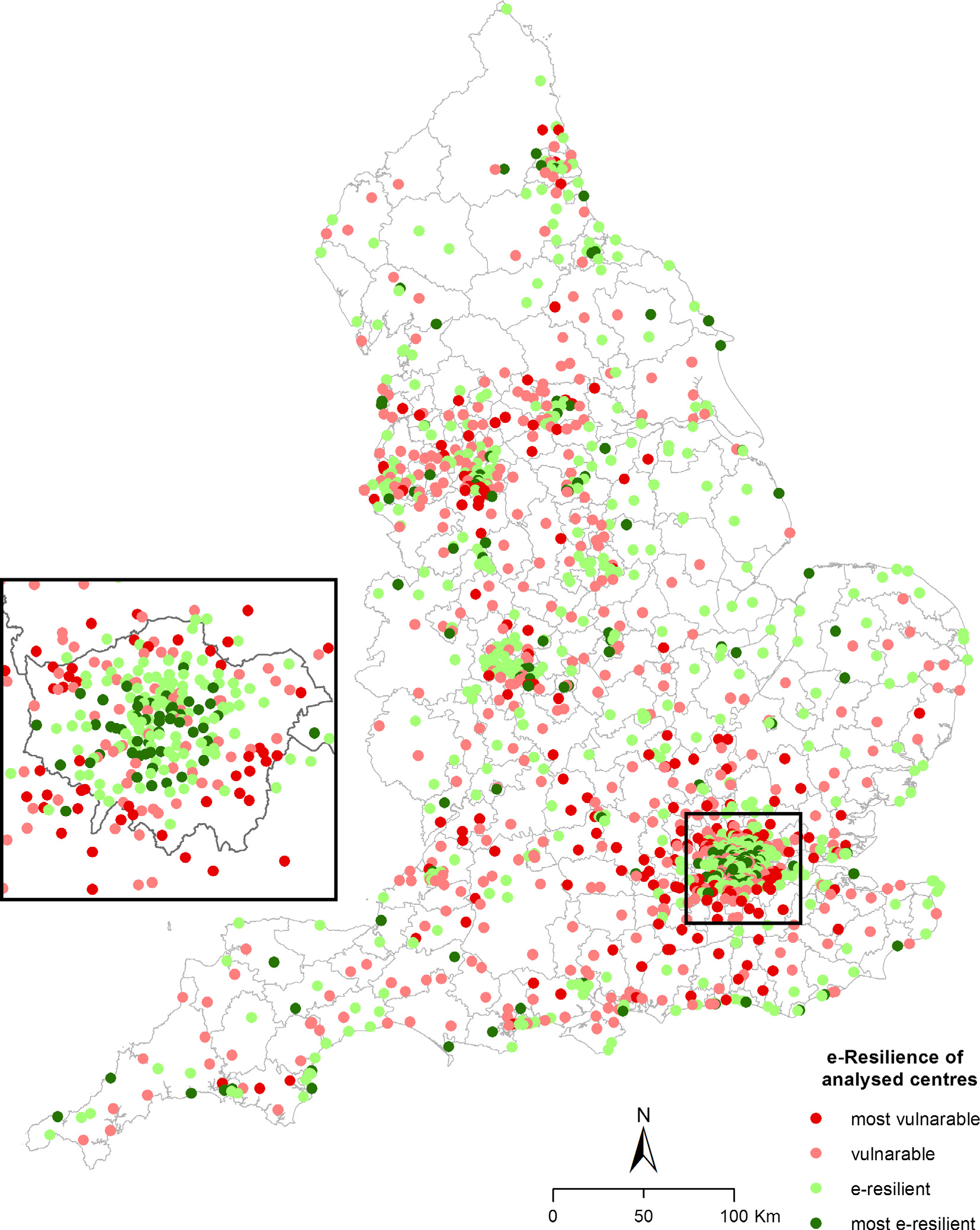About the research
Online sales have been growing exponentially in recent years – accounting in 2015 for over 15% of all UK retail sales – and have had a significant impact on traditional UK high street economic performance. As highlighted by the Digital Highstreet 2020 Report, the growth in online consumption is challenging, as it is reshaping the structure of traditional retail centres and the UK Government has sponsored many activities in recent years in an attempt to redefine traditional retail centres and to make them more competitive. It is therefore important to focus on how the structure of traditional high streets might be impacted by the growth of online shopping and how stakeholders in retail should address the challenges and adapt to this change in demand.
This study, conducted by researchers from the Consumer Data Research Centre (CDRC), explores to what extent retail centres across England are vulnerable and resistant to the growth of online shopping. It introduces the concept of e-resilience as a framework for assessing the extent of the vulnerability and whether it is spatially differentiated across the country. The research project also identifies how e-resilience may be measured and generalised, and develops usable indicators to be used by researchers and retailer stakeholders. These indicators are then calculated for retail centres across England.
Findings, as shown in Figure 1, reveal a geography where attractive and large retail centres – such as the inner areas of the larger urban areas of Greater London, Birmingham or Manchester – are highlighted as least vulnerable to online sales, along with smaller more specialist centres. The researchers argue that large and attractive centres may function as hubs for shopping and leisure whereas small local centres may serve convenience shopping requirements. On the other hand, the centres identified as most vulnerable include many secondary and medium sized centres – predominantly located in the suburban and rural areas of South East England. It is suggested that this may be due to lack of diversity and due to the space not being appropriately configured to a contemporary retail system.
Figure 1: The e-resilience of town centres in Engalnd (Source: Singleton et al., 2016)
The study received funding by the Economic and Social Research Council (ESRC) and is part of two wider projects with the aim of providing insights into the retail sector: Retail Business Datasafe and The e-Resilience of British Retail Centres.
Methodology
This study presents e-resilience as a framework that defines the vulnerability of retail centres to the effects of growing Internet sales, and estimates the likelihood that their existing structure will adapt to or accommodate these changes. E-resilience can be expressed as a balance between the propensity of localised populations to engage with online retailing and the physical retail provision. However, estimating the interaction between potential consumers and retail destinations is increasingly complex.
Constructing a measure of e-resilience for a retail centre requires in-depth knowledge about the characteristics and mix of retail offerings, alongside demographic and Internet engagement characteristics of potential consumers. Figure 2 summarises the range of influences on retail e-resilience as including: connectivity, behaviour, demographics and the retail/service offer.
This research extends the conceptual model of resilience as applied to retail, and is operationalised through a novel methodology that develops two indices that balance both supply and demand influences. The methodology combined a range of data sources to develop two national indicators of retail centre exposure and vulnerability to online sales.
Figure 2: Conceptual framework of e-resilience (Source: Singleton et al., 2016)
In order to measure demand factors and capture influences on Internet engagement behaviour, the researchers combined internet use data from the Oxford Internet Survey (OxIS), socio-demographic indicators from the UK 2011 Census and Internet speed data from http://www.broadbandspeedchecker.co.uk to obtain Internet User Classifications and retail centre catchment profiles. Internet User Classifications and retail catchment profiles were then intersected with the retail supply vulnerability index derived from Local Data Company (LDC) retail data – a nationally expansive record of the location and occupancy of UK retail stores.
The research paper provides an in-depth description of the creation of the composite e-resilience indicator and the calculation of it for retail centres across England.
Findings for policy
The findings have a substantial policy relevance to a variety of key stakeholders looking at the impact of online channels on the changing geography of British retailing. The e-resilience framework provides retailers with better intelligence about their potential exposure to competition from online retailing. As such, this would enable them to formulate a better market response, for example, adopting various forms of multichannel retailing such as ‘Click and Collect’. However, the relevance of the research outputs are not limited to retail stakeholders, as the e-resilience classification may benefit to researchers looking at understanding the contemporary geography of use and engagement with the internet – this is especially pertinent given the ‘online first’ policy for public services.
The researchers summarise the three major implications of this project as follows: “First, it establishes the concept of e-resilience that examines retail centre exposure to the impact of Internet sales, and proposes a new methodology about how such interactions can be measured. Second, a comprehensive classification of retail centres based on their e-resilience levels provides a resource that can be used by a wide range of stakeholders including academics, retailers and town centre managers. For example, such outcomes could be used as assessment tools when evaluating retail centre economic performance. Third, the study adds value to and repositions the focus of current debates on the resilience of traditional high streets, which have predominantly concentrated on supply side measure such as vacancy rates.”
To read the report in full:
Singleton, A. D., Dolega, L., Riddlesden, D., Longley, P. A. (2016) ‘Measuring the spatial vulnerability of retail centres to online consumption through a framework of e-resilience’, Geoforum, 69, pp. 5-18. doi:10.1016/j.geoforum.2015.11.013


